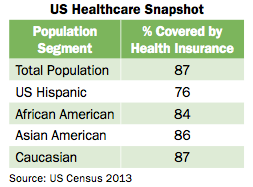Multiethnic Marketing: The Billion-Dollar Upside
Pharmaceutical Executive
Tapping into the fast-growing and lucrative “multicultural” segment requires new and more aggressive approaches to brand planning and consumer engagement.
Today’s era of slow, incremental sales growth presents pharma “c-suite” managers with a fundamental question: where-and how-can we tap new revenues to generate the higher profits that shareholders expect? One opportunity with potentially broad reach is the large bloc of consumers represented by the rich ethnic diversity that anchors the US population of more than 300 million.
Photo: Thinkstock

What we call the “multicultural” or “cross-cultural” constitutes the largest, fastest growing consumer segment in the US market, with significant treatment gaps across therapeutic areas that not only represent potentially millions of new script but also create a strong brand upside as well as a reputational boost from the opportunity for pharma to improve patient outcomes on a national scale. The multiethnic segment is also in the vanguard of the consumer movement when it comes to digital, mobile, and social media use and when communicated to in a relevant way has a higher promotional response. In an effort to gain first-mover advantage, the number of pharma companies investing in multiethnic marketing has tripled within the last decade; but there is still a problem: this pivotal group is not being reached and impacted effectively with the tools of engagement currently employed by big Pharma.
Markets largely untapped
Yes, this is not a new topic for the industry. A “reach out” to multiethnics has probably been included in a brand plan or two, but never quite makes the cut. Perhaps this marketing area felt interesting to you at first, but when it came down to it, the demographics were not tangible enough to fully understand the profit and loss (P&L) impact. I remember years back, as a sales rep in Brooklyn, NY, sitting in a doctor’s office amazed at the level of diversity of patients in the waiting room: Hispanics, African Americans, Chinese, Koreans, Russians, to name just a few. But what was most interesting to me was the thirst for information these patients had and the lack of information available that could speak directly to these consumers.
Being an immigrant myself, having moved to the US from Ukraine in 1990, I knew what it was like to be in a new country, with its different customs, language, and processes. That’s when I decided to dedicate my time and passion to building methodologies and strategies that help my industry colleagues brand teams see multicultural marketing through a focused pharma lens. Specifically, the dynamics of the multicultural markets needed to be quantified in Rx sales terms and positioned in context of an Rx strategy. After heading up multicultural marketing capability for Novartis Pharmaceuticals Corporation, followed by working at leading multicultural agencies, and working on over 30 Rx products specifically in the multicultural category on the client and agency side, I have found that the sales upside can be anywhere from $100 million to over $1 billion per brand. To clarify further, I do not mean the size of the market; I specifically mean a brand specific, incremental sales upside. Given this scale, the conclusion is obvious: the multicultural segment should not just be a tactical marketing mix consideration, but a strategic business development opportunity, initiated and endorsed at the corporate level.
Clearly, there is much room for growth. Historically, big Pharma has not leveraged the US multicultural market place in the way that the finance, travel, CPG, auto, and communications industries have, investing hundreds of millions annually per company. As an example, in 2012, looking at the top 50 spenders in the US Hispanic market alone, the investment range is $30 million to nearly $300 million per company annually, none of which were pharma companies. Why? Multicultural marketing models driven by non-pharma industries did not apply as effectively to pharma due to the other industries different stakeholder mix, specialized analytics, highly restrictive regulations, and unique consumer insights and behaviors. Due to these differences, the business case built for pharma brands was not sufficient to persuade managers to invest.
But the question remains, why not invest? Let’s put things in perspective. The combined multiethnic segment represents over a third of the US population, a bloc nearly the size of Russia’s entire current population. Population wise, the US Hispanic market alone is larger than Spain, and it’s expected to more than double by 2050. We literally have an “emerging market” in our back yard.
Pharma investment on rise
The good news is that although the industry is a bit behind, the needle is certainly moving in the right direction. Five to eight years ago, a few of the major pharma companies started taking a closer look at these market segments. By now, certain organizations have been willing to invest in the multicultural platform as a part of an in-house innovation initiative.
Companies such as Pfizer, Novartis, and Merck & Co. launched a multiethnic or multicultural corporate strategy, while an additional one or two firms have made isolated brand investments in a given year. Fast forward to 2015, we have at least 15 pharma companies now consciously investing into multicultural markets on a brand level; at least 40% of these companies are either exploring or already having a corporate strategy across brands. Hence, labeling multicultural as an exploratory innovation initiative is no longer the case for the industry, but is instead a competitive advantage.

Being first to market is one of the key drivers in securing a leading market share for a given segment. The time is ripe. There are certainly more companies investing, but we are not at a point where the market is cluttered. In other words, there is still plenty of space to gain that first mover advantage and build brand trust and loyalty with this consumer segment.
A similar dynamic has been observed in the retail space, and interestingly enough, over the past five years Walgreens, CVS, Target, and Wal-Mart have all established multicultural operations internally with targeted investments in various cultural segments. A coincidence? Probably not. Three major events in the past seven years have significantly heightened awareness and opportunity within the multicultural health segment overall. First, in 2008, the US presidential campaign showed the power of marketing to and building brand loyalty with US minority populations. Second, in 2010, the US Census came out with the latest population projections highlighting the tremendous growth of minority ethnic and cultural communities. Third, the Obama administration’s Affordable Care Act (ACA) further heightens the opportunity specific to the multicultural health field.
Prime points for discussion
As we look to expand this opportunity further and prepare for brand planning, common topics that often come up for discussion include the following: are traditional marketing efforts sufficient enough to impact these populations, in a positive or negative way? Is scalability of the opportunity sufficient, given the company’s available resources? What are the misconceptions about insurance coverage and use of technology among these groups? And, lastly, where does the budget come from?
Let’s address these in turn.
Incremental reach & impact: One of the most important aspects of pharma marketing is the understanding of the patient journey and how this journey may differ across disparate patient types. After analyzing the differences in the patient journeys for Hispanics, Asians, and African Americans in therapeutic areas such as cardiovascular and metabolic, vaccines, oncology, hematology, respiratory, Alzheimer’s disease, rheumatoid arthritis, hepatitis, multiple sclerosis, and others, we find there is a common thread, which points to significant gaps across cultures within diagnosis, treatment, and adherence rates. These gaps are also known as healthcare disparities.
Certainly not in every case, but in most cases, at least one of the key parts of the patient journey has significant gaps. At times, the gap is in awareness levels, or perhaps the treatment rates across cultures compared to the non-Hispanic white patients is a lot lower. These gaps can be quantified in financials down to a brand level with the idea that if the gap can be closed, there is immediate financial upside to the brand.
The key part here is that to close some of the gaps, an incremental investment is needed to specifically target these audiences, since traditional efforts are clearly less effective in these populations. To use a tactical example within media, using Nielsen, when applied to unduplicated TV viewers, in prime time, across the top 10 English language networks compared to top Spanish language networks, about 70 % of US Hispanics 18+ are only watching Univision. The data thus shows that traditional investments like English language TV are under-reaching this audience.
Furthermore, for the 30% that may be reached by the English language networks, the question is how relevant is the message-can the impact of the creative be even stronger? In a Nielsen study conducted in 2014 across OTC ads that advertised in both Spanish and English, for adults 18+, Spanish language ads outperformed English language ads in brand recall, message recall, and likeability. The takeaway message on this topic is, (1) multicultural audiences are significantly under-reached by traditional marketing efforts; and (2) for the small number that is reached, the message may not be resonating as well.
Scalability of the opportunity: Let’s start with the US Hispanic market, comprising about 55 million consumers and which is expected to more than double by 2050. If this bloc were a country, it would be the 16th largest economy in the world. The African American market is about 42 million consumers and is also growing faster than the non-Hispanic white segment. Using the gap analysis exercise from the previous section, a patient journey gap for Hispanic or African American markets can range anywhere from $100 million to $1 billion per brand. What this simply means is that if through corporate marketing efforts these journey gaps can be closed over time, one brand can bring over $100 million annually as incremental sales. If there are multiple brands in a corporation, the upside is in billions.
Let’s put this in perspective. From a business development view, a corporation can spend hundreds of millions of dollars on R&D to bring a new drug to market and then make $500 million annually in peak sales, through a loss of exclusivity. Here, you can take an existing brand and invest less given the brand is already in market, but the upside is equal or better, making your overall ROI stronger over time. In addition, this upside is purely from closing the gap between the given culture and the non-Hispanic white population. This does not include any other upside that may naturally come from promotion, which would be icing on the cake.
For the Asian market, the story is a bit different. The scale is not as significant. However, the ROI is tremendous. For example, a standard recommended investment within the Chinese market place is about $400,000 to $600,000 annually, but the ROI seen on these investments could be closer to a 4:1. In this case, the question is not of scalability, but merely choosing a better investment in your current marketing mix (e.g., when looking across all the tactics that are in the $400,000 range, what tactics are returning lower ROIs-or do you know what the ROI is across all the tactics of $400,000 and under?) I challenge everyone to ask this question, as investing in the various Asian segments, or the US Russian speaking market, may drive a stronger ROI versus existing tactics in the marketing mix.
For companies that have invested consistently every year and maintained a strong investment level across ethnic groups and cultures, they possess disproportionate market shares within the cultures they have invested in. What’s most staggering is the potential scale upside for the brands and a huge win for patients. The impact of even moving the needle in closing some of these gaps is a tremendous turning point in patient outcomes, from quality-of-life benefits to improving survival rates. This is “patient centricity” at a whole new level, as here we have an opportunity to connect with patients in a highly individual, targeted way.
Health Insurance: This is a really easy one to parse. As of 2013, health insurance coverage rates across population segments are illustrated in the chart below. The biggest question on everyone’s mind is the insurance coverage for the US Hispanic group. The rate is actually 76% coverage, compared to 87% in the white population.

Certainly it’s lower than for non-Hispanic whites, but the real point is that the vast majority of these people are covered. Also, considering the scale and future growth, the numbers are very strong and are from 2013, which does not account for full ACA impact.
Technology consumption: Generally speaking, multicultural consumers are not only on par with non-Hispanic white consumers, but are leading the total US population in various consumption behaviors within digital, mobile, and social platforms. Certainly, there are variations when we start to break consumption down by channel, by age, gender, etc., but overall the multicultural consumer tends to over-index in various areas.
Here are the key highlights:
- US Hispanics watch more video than non-Hispanic consumers, are more engaged on mobile use, and are the most active users of social media networking sites.
- 70% of African Americans and 71% of Hispanics own a smartphone, versus 61% of non-Hispanic whites.
- 73% of African Americans age 18 or over versus 72% of non-Hispanic whites use social networking.
- 22% of African Americans age 18 or over Tweet versus 16% of whites.
- Asian Americans have a higher smartphone penetration and adoption of tablets than the overall population.
Budget source: No question, this is a tricky and potentially sensitive topic. My recommendation is to create an internal risk-share model where the initial investment, “pilot,” “test,” and “proof of concept,” is co-shared between the brand budget and a matched amount of funds allocated outside of the brands. This way, there is shared accountability and a guarantee of internal brand team support, along with sufficient funding for an initial investment.
In allocating your investment, the last thing you want to do is to shortchange your test. Typically, this can cost anywhere from $500,000 to $3 million. But what’s most important is the mindset going into this test, which is not only to see whether this works or not, but more to learn, optimize, and scale up. Scaling up can mean finding funding in the millions of dollars, which in most cases the brand budgets will not be able to support alone. This is where we have to make a call beyond the brand teams promotional spend.
Given the significant upside of the opportunity in most cases, an incremental budget allocation is needed. However, the spirit of this allocation is not just about the typical promotional spend increase. It’s a business development opportunity. As is the case when bringing a new brand to market and being in a pre-launch stage, new budget is allocated. Similarly, with this potentially being a billion-dollar upside for a company over time, an incremental investment outside of the current brand team’s funding is certainly worth the commitment.
Engagement signals strong: Don’t miss out
In summary, the multicultural segment is the largest, fastest growing consumer segment with significant treatment gaps across therapeutic areas that collectively are worth billions of dollars in pharma revenues and profits. This creates a tremendous opportunity for pharma to improve patient outcomes on a national scale. The multiethnic segment also happens to be a savvier player when it comes to digital, mobile, and social media use, but it’s not being reached and impacted effectively by current practices. The evidence does show, however, that when communicated properly, the multiethnic cohort delivers a higher promotional response. We are at a point where not investing is not just a financial miss, but a driver of competitive disadvantage. Changing that dynamic through a solid investment is worth it. It may be the largest marketing mix opportunity for the industry in an era of declining expectations.
Steven Millerman is President and Founder of Emcay. He can be reached at steven.millerman@emcay.net.
